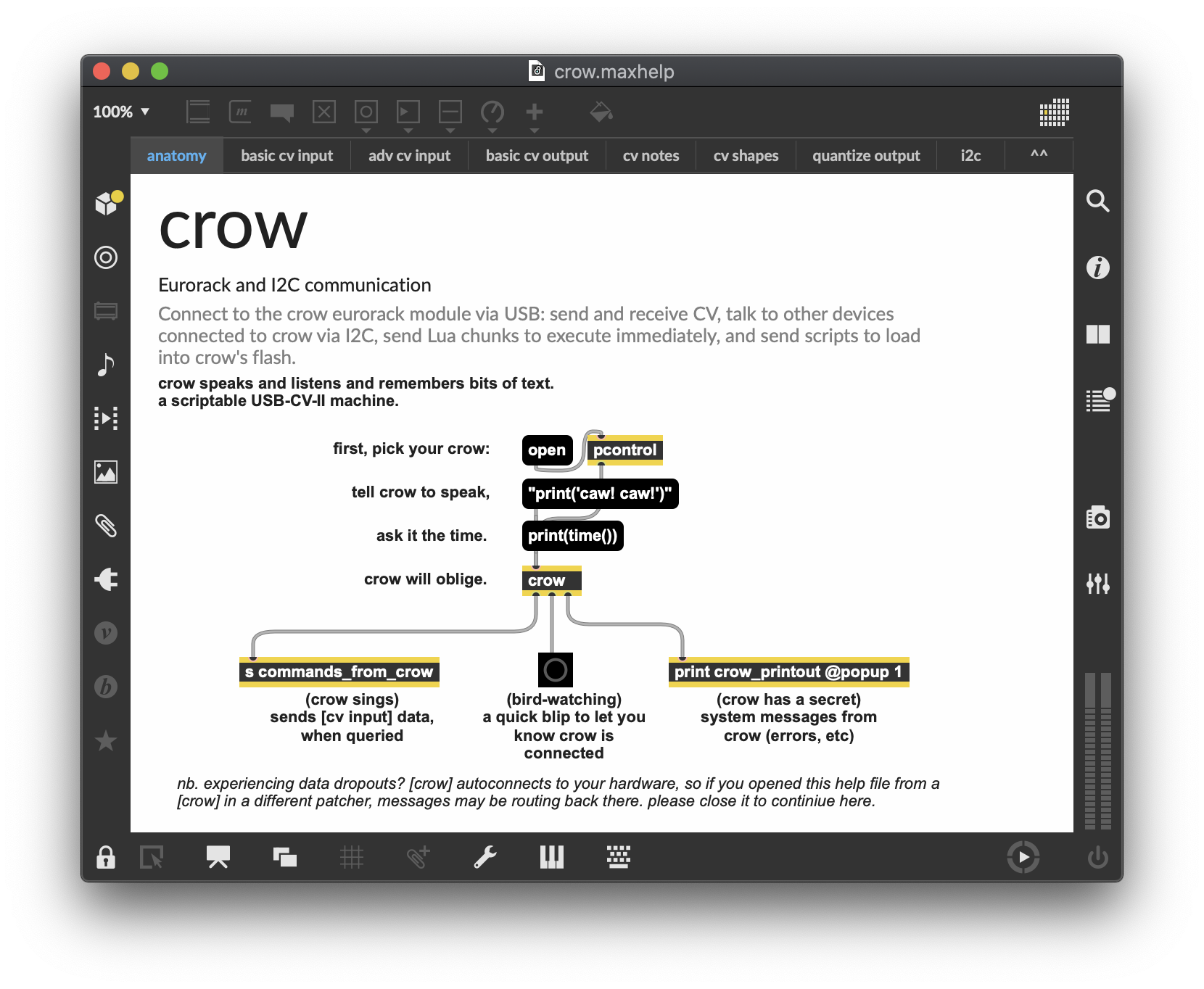Max and Max for Live
Max is a powerful visual coding language that has integrations with Ableton Live.
We have created a custom [crow] object and several helpful abstractions for Max, to welcome crow into your existing and future patches.
Using the [crow] object, we have also created a suite of Max for Live devices which help connect your Eurorack system and Ableton Live in ways beyond simple clocking.
Before we begin: download the latest Max and Max for Live releases.
If any of the devices or objects are crashing Max or Ableton Live upon load, please follow the clean install steps from Cycling ‘74.
Max
Install
After downloading the entire crow-max-and-m4l repo, extract the zip file and you should get two unique folders: crow_max and crow_m4l.
Open Max > Options > File Preferences > highlight User Library > the rightmost icon in the bottom bar should illuminate. Clicking this icon will open the User Library folder, where you can drop the crow_max folder.
If you are performing an update of an existing crow_max installation, you can simply allow the system to replace the existing files. If you have previous crow files in your User Library (or anywhere along your Max search path), please delete them and start fresh with crow_max.
Restart Max and you should be able to instantiate the crow object!
Help Patcher
Right-click the [crow] object and select Open crow Help, which will reveal:

- anatomy: demonstration of the necessary signal flow to start patching with crow in Max.
- cv input: showcases reading CV through crow’s 2 hardware inputs either on-demand, as a stream, or when a signal crosses a specified threshold.
- basic cv output: setting CV slew and specifying target voltages for crow’s 4 hardware outputs. introduces
sprintftechniques to help assign values dynamically. - cv notes: showcases MIDI-to-CV translation for v/8 notemaking. also introduces pulse and ar commands.
- cv shapes: introduction to actions as user-definable envelopes/lfo’s.
- i2c: demonstrates i2c connectivity + simple interactions with Just Friends (Whimsical Raps). this seemed the most interesting application, though the fundamental approach is translatable to any i2c device that has pre-defined Teletype interactions (w/, ER-301, Ansible, etc).
- ^^: an index of system commands that report on connected hardware + flash new scripts to the module.
[crow.] library
In addition to the crow object, there are many helper objects which can aid in development of crow Max and Max for Live applications. Each object comes with its own help-patcher and built in Max reference page.
crow.volts: directly set one of crow’s outputs to a voltage (with an optional slew time)crow.inputs: a bpatcher gui to easily access data from crow’s inputs within Maxcrow.ar: easily configure and trigger an attack-release envelope on any of crow’s outputscrow.adsr: easily configure and trigger an ADSR envelope on one of crow’s outputscrow.var: assign a value, table, variable, or function return to a variable (or to an element of a table)crow.function: tell crow to execute a function, or generate a function call to pass to anothercrow.object.crow.dyn: quickly format a dynamic variable.crow.n2v: convert semitones to V/oct voltage levels.
Max for Live
Install
Max installation is not required to use the devices in crow_m4l.
After downloading the entire crow-max-and-m4l repo, extract the zip file and you should get two unique folders: crow_max and crow_m4l.
Open Live (9 or 10) Suite, running at least Max 7.3.6. Place crow_m4l wherever you’d prefer it living longterm on your hard drive. Open Live and drag the folder into Live’s browser, under PLACES.
If you are updating a previous installation, just replace the previous crow_m4l folder’s contents with the new files.
Getting started with crow + Max for Live
There is a full PDF manual for the devices in the GitHub repo.